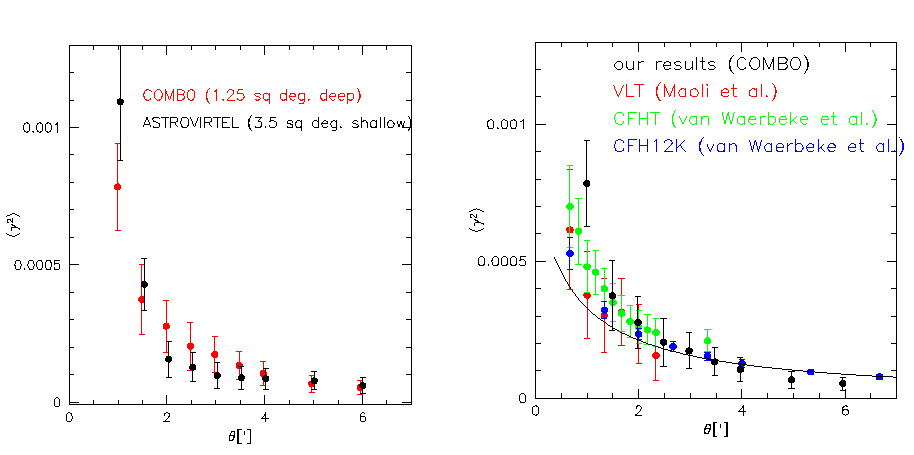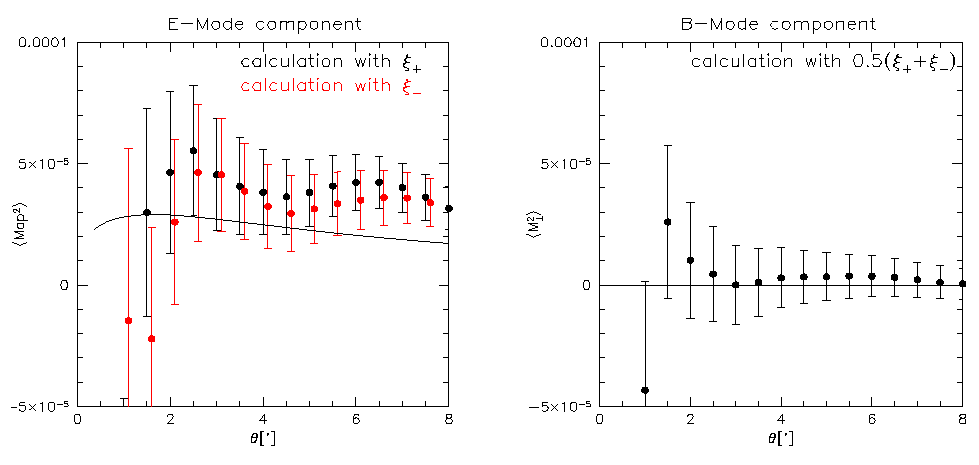Classifying
Objects by
Medium-Band
Observations
- a spectrophotometric
17-filter survey -
project: Comparison of Cosmic Shear Results in Deep and Shallow Surveys

Fig.1: Left hand side: the top-hat variance for the deep (COMBO-17) and shallow (ASTROVIRTEL) parts of our survey. Right hand side: the COMBO-17 results in comparison with previous measurements from surveys of comparable depth. The curve corresponds to theoretical predictions for a LambdaCDM cosmology.

Fig.2: Left hand side: The Map statistics (E-mode) in COMBO-17. The signal has been obtained independently in two different ways from basic shear correlation functions. Right hand side: the B-mode in the COMBO data. Being consistent with zero is an excellent check for the integrity of data and analysis.
A cosmic shear analysis aims at the direct measurement of the cosmological power spectrum and the determination of cosmological parameters (Omega0, sigma8, Gamma) with weak lensing techniques. The large-scale structures lead to an observable net correlation of galaxy ellipticities, whose orientation is assumed to be random in the case of no lensing. Two ways to obtain these correlations are the top-hat variance that considers pair-wise galaxy ellipticities within circles and the Map statistics that calculates the tangential ellipticity components of galaxies within circles (the components are calculated with respect to the circle center).
Several measures of these quantities have been obtained so far. Fig. 1 shows our preliminary results for the top-hat variance for the deep and shallow parts of our survey and the comparison to previous studies. Fig. 2 discusses our result for Map in the COMBO-17 data. While a significant measure for this E-mode of the signal is more difficult to obtain than for the top-hat variance, it allows an important test for systematics in the measurement process. Obtaining a vanishing signal when rotating all galaxies by 45 degrees (the B-mode of the signal) is an efficient sanity check for data and analysis techniques (see Fig. 2).
However, B-mode components can be generated by source clustering or intrinsic galaxy alignments. These effects are expected to be most important in shallow
surveys where the redshift range probed is small. Having several square degrees of different depth at hand [very deep data from the COMBO-17 survey and shallow
data (approx. 4000 s integration time) from an ASTROVIRTEL program], one of the main goals of study is to test these hypotheses and quantify systematic effects due to probing different redshift distributions.
Contact person: Thomas Erben (terben@astro.uni-bonn.de)
More information available at the Bonn lensing homepage and the Edinburgh
lensing homepage .
Back
to COMBO-17 science page
Last update Nov 5, 2002, CW

